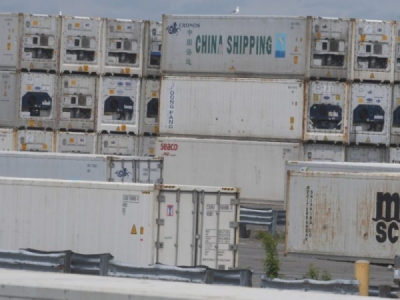
Posted on June 6, 2019
Massport officials are pushing to keep the large new container cranes they plan to buy off of the list of tariffs on Chinese imports, saying that the higher levy on goods from China would add millions of dollars to the project to help the Conley Terminal handle the increasingly larger ships companies use.
“Should the tariff be implemented on these cranes, the cost will increase by at least $10 million, significantly impacting Massport’s ability to modernize Conley Terminal,” Massachusetts Port Authority officials wrote in a letter to the delegation.
Massport is in the process of acquiring three large ship-to-shore cranes so the Paul W. Conley Marine Terminal can handle larger vessels.
President Trump has ordered tariffs on a wide range of the country’s imports from China in several rounds over the past year, and the administration has discussed adding more in the future as the two global powers attempt to negotiate an agreement. Massport Port Director Lisa Wieland said the cranes were slated to be included in a previous raft of tariffs, but Massport and other related organizations successfully lobbied to keep them off of it then.
“These cranes are only manufactured in China, and there are no alternatives,” Wieland told the Herald.
These cranes, which are larger than the current ones in the port and would arrive in 2020, would allow the terminal to handle the much bigger ships that Massport says companies increasingly are using. And right now, the port has a hard time dealing with the higher end of the cargo ships that are looking to come into the port.
“I’m frequently asked, ‘When are the big ships coming?’ The big ships are coming right now,” Wieland said. “There’s such strong demand for this.”
She said the port is on track to see more than 5% growth in traffic this fiscal year over last, but will need the major work to keep the books shipshape.
“With all the mergers and larger ships, you need deep waters and you need some infrastructure changes to accommodate these deep ships,” said Luiz de Costa of the regional trade organization CONECT. “If you want to be able to call in a megaship, you have to be able to handle it.”
The $850 million is going toward a combination of improvements of the terminal itself and the ocean floor leading up to it. A $350 million dredging contract to deepen the channel near the port is about 40% done, with 4.6 million cubic yards out of about 12 million dredged so far.
“It opens up opportunities to have service on trade lanes we don’t currently have,” Wieland said, such a route from Southeast Asia and other routes by the increasingly consolidated shipping companies.
The Conley facility is a smaller port compared to the massive Port of New York and New Jersey, but de Costa said that can be a competitive advantage, as it’s less crowded.
Source: bostonherald.com





